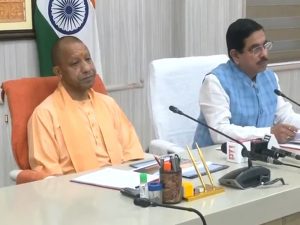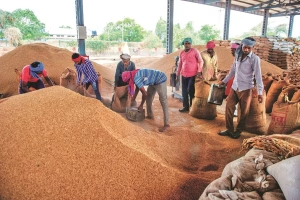Lucknow, Uttar Pradesh – In a significant development for Uttar Pradesh’s energy and agricultural sectors, CM Yogi’s renewable energy vision was prominently showcased during a high-level joint review meeting held on Thursday. Chief Minister Yogi Adityanath welcomed Union Minister for Consumer Affairs, Food and Public Distribution, Prahlad Joshi, to his official residence for a comprehensive discussion focusing on three critical schemes: the PM Surya Ghar Free Electricity Scheme, PM KUSUM Scheme, and wheat procurement for the Rabi Marketing Year 2025-26.
The meeting highlighted CM Yogi’s renewable energy vision that has positioned Uttar Pradesh as a frontrunner in solar energy adoption and implementation. During the discussions, CM Yogi informed the Union Minister about the state’s remarkable performance in both solar energy initiatives and wheat procurement processes, emphasizing that these achievements align perfectly with Prime Minister Narendra Modi’s vision for a self-reliant India.
“Uttar Pradesh is committed to achieving the best possible results in renewable energy and agricultural support systems,” stated CM Yogi Adityanath, underlining his dedication to transforming the state’s energy landscape while supporting farmer welfare.
Union Minister Praises CM Yogi’s Renewable Energy Vision

Union Minister Prahlad Joshi expressed his admiration for CM Yogi’s renewable energy vision and congratulated the state government for its exceptional efforts in implementing central schemes. He noted that Uttar Pradesh has emerged as a role model for other states, demonstrating how effective governance can respond to growing energy demands while supporting agricultural communities.
“The work being done in Uttar Pradesh under CM Yogi’s renewable energy vision is setting an example for the entire nation,” Joshi remarked during the meeting. He specifically highlighted the transformative initiatives in religious and cultural centers like Ayodhya and Varanasi as exemplary models that other states could emulate.
The mutual respect between central and state leadership was evident as both officials provided essential guidance to state and central government representatives present at the meeting. In a gesture symbolizing the strong center-state coordination, CM Yogi honored Union Minister Joshi with a gift representing the state’s successful One District One Product (ODOP) initiative, accompanied by a bouquet of flowers.
Comprehensive Review of People-Centric Schemes Under CM Yogi’s Renewable Energy Vision
During the meeting, CM Yogi Adityanath emphasized that the session focused on reviewing three critical schemes that directly impact common citizens, particularly farmers. “Under the guidance of Prime Minister Narendra Modi, Uttar Pradesh is making remarkable progress in these initiatives,” he stated, reinforcing the state’s commitment to excellence in scheme implementation.
The Chief Minister detailed how CM Yogi’s renewable energy vision is being actualized through multiple policy frameworks, including the Uttar Pradesh Solar Energy Policy 2022, which aims to provide affordable and reliable solar energy access to all citizens. He also mentioned the complementary Uttar Pradesh Bio Energy Policy 2022 and the recently introduced Uttar Pradesh Green Hydrogen Policy 2024, which collectively form a comprehensive approach to sustainable energy development.
This integrated policy framework demonstrates how CM Yogi’s renewable energy vision extends beyond conventional solar applications to embrace a holistic renewable energy ecosystem. The synchronization of these policies reflects a strategic approach to energy transition that considers both immediate needs and long-term sustainability goals.
Ambitious Targets Set Under CM Yogi’s Renewable Energy Vision
One of the most striking aspects of CM Yogi’s renewable energy vision is the ambitious target of generating over 22,000 MW of solar energy by 2027. This goal, established under the state’s Solar Policy, encompasses various implementation strategies, including:
- Development of large-scale solar parks
- Solarization of agricultural feeders and private on-grid pumps
- Installation of solar plants along expressways and railway tracks
- Promotion of solar energy equipment manufacturing industry
To support this extensive solar expansion, the state government is also enhancing the transmission network infrastructure essential for solar projects. This comprehensive approach under CM Yogi’s renewable energy vision addresses both generation capacity and the distribution challenges that often hamper renewable energy integration.
PM Surya Ghar Yojana: A Key Component of CM Yogi’s Renewable Energy Vision
The review meeting revealed impressive progress in the implementation of the PM Surya Ghar Yojana in Uttar Pradesh. CM Yogi reported that the state has received over 10 lakh applications under this scheme, with more than one lakh installations already completed. These figures underscore the popular support for CM Yogi’s renewable energy vision among the state’s citizens.
Demonstrating his commitment to accelerating implementation, the Chief Minister issued directives to UPNEDA officials to expedite connections for all applicants through a well-organized campaign. This hands-on approach characterizes CM Yogi’s renewable energy vision, which combines ambitious targets with practical implementation strategies.
Looking ahead, the Chief Minister outlined plans to more than double the monthly solar installations from the current 11,000 to over 22,000 in 2025-26. To ensure proper monitoring and accountability, he instructed officials to establish district-wise, DISCOM-wise, and municipal corporation-wise targets, all of which would be integrated into the CM dashboard for regular monitoring and review.
“Our goal is to ensure that CM Yogi’s renewable energy vision reaches every household in Uttar Pradesh that has expressed interest in adopting solar energy,” a senior official commented after the meeting.
Strategic Implementation Plan for Solar Rooftops
During the meeting, CM Yogi issued specific directives regarding the creation of a comprehensive vendor list to handle the installation of solar rooftops for the 10.73 lakh applications received on the portal by March 2025. This systematic approach is characteristic of CM Yogi’s renewable energy vision, which emphasizes thorough planning and execution.
Understanding the human resource requirements for this massive undertaking, the Chief Minister also focused on training initiatives to create more “Surya Mitras” – specialized technicians for solar installations. He directed that training programs be provided through Polytechnic institutes across the state, creating both employment opportunities and technical capacity for solar expansion.
“The development of skilled technicians is an integral part of CM Yogi’s renewable energy vision, as it addresses both the employment and implementation challenges simultaneously,” explained an official from the state’s energy department.
PM Kusum Yojana: Strengthening Rural Energy Security
The review of the PM Kusum Yojana revealed another area where Uttar Pradesh is leading the nation under CM Yogi’s renewable energy vision. The state has achieved remarkable success in the solarization of private pumps, directly benefiting the agricultural sector while reducing dependency on conventional energy sources.
CM Yogi stressed that the solarization of private tube wells should be pursued on a mission mode, engaging quality vendors in the process. He also emphasized the importance of raising farmer awareness about water conservation, highlighting how CM Yogi’s renewable energy vision integrates energy transformation with sustainable agricultural practices.
The meeting also discussed special initiatives for marginalized communities. The Chief Minister mentioned that Vantangiya villages and tribal communities in Sonbhadra, Mirzapur, Chitrakoot, and Chandauli are being provided with free solar panels by the state government. This inclusive approach ensures that CM Yogi’s renewable energy vision benefits all sections of society, particularly those historically underserved.
Urban Solar Integration in CM Yogi’s Renewable Energy Vision
Expanding the scope of CM Yogi’s renewable energy vision to urban areas, the Chief Minister directed that solar parks be developed in all 17 municipal corporations across the state. He instructed municipal corporations to provide the necessary land for these projects, demonstrating how local government resources can be mobilized to advance renewable energy goals.
Furthermore, CM Yogi directed that city streetlights should be connected to these solar parks, creating an integrated urban solar ecosystem. This directive showcases how CM Yogi’s renewable energy vision extends to practical applications that improve urban infrastructure while reducing conventional energy consumption.
“The integration of solar energy into urban infrastructure represents a forward-thinking aspect of CM Yogi’s renewable energy vision that addresses both energy efficiency and urban sustainability,” noted an urban development expert familiar with the state’s initiatives.
Wheat Procurement: Supporting Farmers Under CM Yogi’s Renewable Energy Vision


While CM Yogi’s renewable energy vision primarily focuses on transforming the energy landscape, the review meeting also addressed agricultural support systems, particularly wheat procurement for the Rabi Marketing Year 2025-26. The Chief Minister expressed confidence that Uttar Pradesh would meet its wheat procurement target within the stipulated time.
As of April 9, over 1.40 lakh metric tonnes of wheat had been procured from 26,641 farmers, marking excellent progress compared to previous years. This achievement reflects the state government’s commitment to supporting farmers while implementing CM Yogi’s renewable energy vision, demonstrating that energy transformation and agricultural progress can advance simultaneously.
“Our approach combines CM Yogi’s renewable energy vision with strong agricultural support systems, ensuring that farmers benefit from both modern energy solutions and traditional procurement guarantees,” explained a senior official from the food and civil supplies department.
Innovative Outreach Strategies for Farmer Engagement
The meeting highlighted innovative strategies employed to reach farmers before the harvest season. District and divisional officers were dispatched to villages to inform farmers about the Minimum Support Price (MSP) and encourage them to bring their wheat to procurement centers. This proactive approach aligns with CM Yogi’s renewable energy vision of accessible and responsive governance.

With the Government of India’s approval to operate mobile procurement centers, the state is now literally reaching farmers’ doorsteps. Teams are engaging with farmers across all 826 development blocks, making procurement more accessible than ever before. Special arrangements for seating and meals for farmers at every procurement center further demonstrate the farmer-centric approach that complements CM Yogi’s renewable energy vision.
To ensure prompt payments, the Chief Minister has directed that all centers remain open even on holidays, with extended working hours to prevent any inconvenience to farmers. This attention to operational details reflects how CM Yogi’s renewable energy vision extends beyond policy formulation to practical implementation that considers citizens’ needs.
Union Minister’s Endorsement of State’s Progress
Union Minister Prahlad Joshi’s comments during the meeting provided strong central government endorsement of CM Yogi’s renewable energy vision. He expressed gratitude to the Chief Minister and commended the state’s performance across various schemes, including wheat procurement and the PM Surya Ghar initiative.
Joshi specifically praised Uttar Pradesh’s excellence in the renewable energy sector, highlighting the transformative work in Ayodhya and Varanasi. He emphasized that these efforts serve as examples for other states to follow, reflecting the national significance of CM Yogi’s renewable energy vision.
The Union Minister suggested further improvements through targeted campaigns, with the ultimate goal of establishing Uttar Pradesh as a model for the entire country. He noted that the state is well-prepared and moving in the right direction to meet growing energy demands, validating the strategic foresight embodied in CM Yogi’s renewable energy vision.
Integration of Technology in Implementation
A notable aspect of CM Yogi’s renewable energy vision is the integration of technology in monitoring and implementation. The directive to incorporate scheme targets into the CM dashboard reflects a data-driven approach to governance that enables real-time monitoring and timely interventions.
This technological integration allows for better tracking of progress, identification of bottlenecks, and optimization of resource allocation. Such systems support the effective implementation of CM Yogi’s renewable energy vision by providing decision-makers with accurate, up-to-date information on various initiatives.
“The technological backbone supporting CM Yogi’s renewable energy vision ensures transparency, accountability, and efficiency in implementation,” commented a technology expert associated with the state’s governance innovations.
Economic Impact of CM Yogi’s Renewable Energy Vision
The economic implications of CM Yogi’s renewable energy vision extend far beyond the energy sector. The expansion of solar energy installations is creating numerous direct and indirect employment opportunities, from manufacturing and installation to maintenance and operations.
Moreover, the localization of solar equipment manufacturing, as emphasized in the state’s policy framework, promises to establish Uttar Pradesh as a hub for renewable energy technology. This industrial development aspect of CM Yogi’s renewable energy vision aligns with broader economic development goals while supporting environmental sustainability.
The agricultural benefits of solar pump installations include reduced operating costs for farmers and improved reliability of irrigation systems. These economic advantages make CM Yogi’s renewable energy vision particularly relevant for a state with a substantial agricultural economy.
Environmental Benefits and Climate Action
While not explicitly discussed in the meeting, the environmental benefits of CM Yogi’s renewable energy vision are significant. The ambitious solar energy targets directly contribute to reducing carbon emissions, improving air quality, and mitigating climate change impacts.
By integrating renewable energy into both rural and urban contexts, CM Yogi’s renewable energy vision promotes a sustainable development model that balances economic growth with environmental responsibility. This approach positions Uttar Pradesh as a leader in climate action among Indian states.
The focus on water conservation alongside solar pump installations further demonstrates how CM Yogi’s renewable energy vision addresses interconnected environmental challenges, recognizing that sustainable energy and water management are complementary goals.
The Path Forward for CM Yogi’s Renewable Energy Vision
The joint review meeting between CM Yogi Adityanath and Union Minister Prahlad Joshi marked a significant milestone in the implementation of CM Yogi’s renewable energy vision. The discussions revealed substantial progress across multiple schemes while setting ambitious targets for future achievements.
As Uttar Pradesh continues to advance in solar energy adoption and agricultural support systems, CM Yogi’s renewable energy vision stands as a comprehensive framework that integrates technological innovation, inclusive development, and sustainable practices. The synergy between state and central leadership evident in this meeting suggests strong continued support for these initiatives.
With clear targets, strategic implementation plans, and robust monitoring mechanisms in place, CM Yogi’s renewable energy vision is well-positioned to transform Uttar Pradesh’s energy landscape while supporting farmer welfare. As Union Minister Joshi noted, these efforts could indeed establish the state as a model for the entire nation in responding to growing energy demands while supporting sustainable development.

